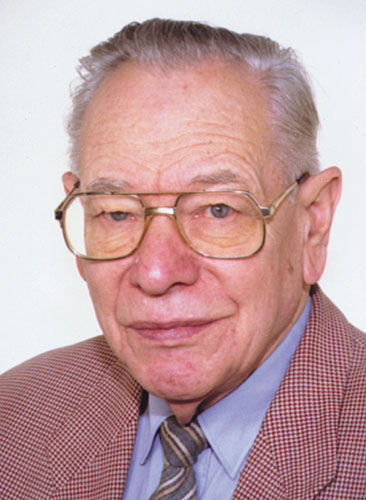DR. RANDOLPH RIENSCHNEIDER
Professor Emeritus of Biochemistry and Chemistry
Berlin, Germany
 Dr. rer.nat., Dr. med.h.c. Randolph Riemschneider was born on November 17, 1920,
in Hamburg, Germany. He studied Chemistry in Göttingen, Hamburg, and Leipzig, and
earned a degree in Chemistry in 1941. After serving in the army, he worked in
industry preparing synthetic gasoline by hydrogenation at 500?C from April 1943
to July 1944, while simultaneously writing his thesis and working toward his
habilitation. His dissertation, which discussed synthetic lubricants from products
of hydrogenation, was accepted by the University of Jena in 1945; he received his
habilitation in October 1946 from the University of Berlin, having discovered the
reaction of hexachlorcyclopentadiene and unsaturated compounds, which resulted in
M410, a substance 1000 times stronger than DDT, in 1944.
Dr. rer.nat., Dr. med.h.c. Randolph Riemschneider was born on November 17, 1920,
in Hamburg, Germany. He studied Chemistry in Göttingen, Hamburg, and Leipzig, and
earned a degree in Chemistry in 1941. After serving in the army, he worked in
industry preparing synthetic gasoline by hydrogenation at 500?C from April 1943
to July 1944, while simultaneously writing his thesis and working toward his
habilitation. His dissertation, which discussed synthetic lubricants from products
of hydrogenation, was accepted by the University of Jena in 1945; he received his
habilitation in October 1946 from the University of Berlin, having discovered the
reaction of hexachlorcyclopentadiene and unsaturated compounds, which resulted in
M410, a substance 1000 times stronger than DDT, in 1944.
During the US-Soviet occupation of Jena from May to September1945, Dr. Riemschneider wrote several illustrated essays, including Rätsel der Sonnenflecken, Erde ohne Mond, and Das großte Kraftwerkder Erde ist die Erde selbst; he also penned the book Englisch nach Zeitwortsystem. From 1947 to 1949 he worked at Lohmann's Institute in Berlin, and engaged in research and lecturing on Organic and Biological Chemistry. He supervised over 200 theses and dissertations at various universities over the next 40 years. Simultaneously, he worked with industry and spent over 50 years collaborating with research institutes in Japan, Brazil, the USSR, the USA and Switzerland. In 1979 he won the Pola Award from the Japan Chemical Society.
More specifically, his career includes holding the positions of Lecturer in Organic Chemistry in the Mathand Nat. Facility in 1948, and of Lecturer in Biochemistry at the Medical Faculty in East Berlin in 1949. In January 1950 he moved to the Free University in West Berlin; four years later, he was appointed as a Professor there. He spent 1957 in the US, and was then made Chair of Biochemistry at FU in 1958. That same year, he also became Director of the Biochemistry Institute. Between 1962 and 1973, he set up the Institute Central de Quimica da Universidade Federal de Santa Maria (UFSM) in Rio Grande do Sul, Brazil, and served as Coordinating Director. In 1973 he received a Doctor honoris causa from UFSM, and the following year, he was named Professor honoris causa there. He became a Professor Emeritus of FU in 1987, and has since then continued his research as a Consulting Chemist in industry.
Since the early years of his lengthy career, he has conducted extensive research in a variety of areas. His areas of study include Polyacyl Chemistry; specifically, o-Diacetylbenzene in 1937. In the field of pest control, he has worked with the insecticides DDT, HCH, DIEN, and Thiodan, and also on nonphysiological compounds derived from naturally occurring ones, such as isolysine, tripeptides (L-X-D-Y-L-Z), and others. Since 1943 he has worked with synthetic lubricants, thiocarbamates from rhodanides (Riemschneider reaction), the thermocycle of C6 alcines at 500+ °C in aromatic systems, C5Cl6 forming endo-adducts in DIEN synthesis, and (CN)4 ethylene as philodiene (1952). In the field of cytorrhyzed yeasts, he has conducted research on animal food additives and cytocatalyzer as a cosmetic additive. Other areas of research include aphrodisiacs; organ extracts (natural, synthetic, cell-cultured based BSE-free); metabolism activating remedy Cellryl (in 1972 in Japan); Stereochemistry, including cis-trans-asymmetry and axis ring aggregates 52; Antiknocks AK 33X: substitution of Pb by Mn compounds in 1952; and cannibalism in mammals by anti-B6-vitamins. In 2011-2013 he summarized all his extensive findings (published and hitherto non-published ones) to 25 projects in "75 Years Chemistry- Re-Reading", 6 parts with 5570 pages: ISBN 978-1-882292 (28-8, 34-9, 35-6, 36-3, etc.).
Copyright © 2015 The Bibliotheque: World Wide Society